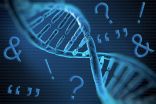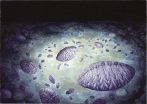(Press-News.org) A team of New York University scientists has developed a technique that prompts microparticles to form ordered structures in a variety of materials. The advance, which appears in the Journal of the American Chemical Society (JACS) as an "Editors' Choice" article, offers a method to potentially improve the makeup and color of optical materials used in computer screens along with other consumer products.
The work is centered on enhancing the arrangement of colloids--small particles suspended within a fluid medium. Colloidal dispersions are composed of such everyday items such as paint, milk, gelatin, glass, and porcelain, but their potential to create new materials remains largely untapped.
Notably, DNA-coated colloids offer particular promise because they can be linked together, with DNA serving as the glue to form a range of new colloidal structures. However, previous attempts have produced uneven results, with these particles attaching to each other in ways that produce chaotic or inflexible configurations.
The NYU team developed a new method to apply DNA coating to colloids so that they crystallize--or form new compounds--in an orderly manner. Specifically, it employed a synthetic strategy--click chemistry--introduced more than a decade ago that is a highly efficient way of attaching DNA. Here, scientists initiated a chemical reaction that allows molecular components to stick together in a particular fashion--a process some have compared to connecting Legos.
In a previous paper, published earlier this year in the journal Nature Communications, the research team outlined the successful execution of this technique. However, the method, at that point, could manipulate only one type of particle. In the JACS study, the research team shows the procedure can handle five additional types of materials--and in different combinations.
The advance, the scientists say, is akin to a builder having the capacity to construct a house using glass, metal, brick, and concrete--rather than only wood.
"If you want to program and create structures at microscopic levels, you need to have the ability for a particle to move around and find its optimal position," explains David Pine, a professor of physics at NYU and chair of the Chemical and Bioengineering Department at NYU Polytechnic School of Engineering. "Our research shows that this be done and be achieved with multiple materials, all resulting in several different types of compounds."
INFORMATION:
The work was conducted by researchers at NYU's Molecular Design Institute and Center for Soft Matter Research and at South Korea's Sungkyunkwan University. The paper's other authors were: Yufeng Wang of the Center for Soft Matter Research and Molecular Design Institute; Yu Wang and Xiaolong Zheng of the Molecular Design Institute; Etienne Ducrot of the Center for Soft Matter Research; Myung-Goo Lee and Gi-Ra Yi of Sungkyunkwan University's School of Chemical Engineering; and Marcus Weck of the Molecular Design Institute.
The research was supported, in part, by grants from the U.S. Army Research Office (W911NF- 510 10-1-0518), the National Research Foundation of Korea (NRF-2014S1A2A2028608), and by the National Science Foundation's Materials Research Science and Engineering Center (MRSEC) Program (DMR-0820341).
NYU's center is one of 24 MRSECs in the country. These NSF-backed centers support interdisciplinary and multidisciplinary materials research to address fundamental problems in science and engineering.
For more on the NYU MRSEC, go to http://mrsec.as.nyu.edu/page/home.
DOI: 10.1021/jacs.5b06607
Women are more likely to smoke during pregnancy when they live in areas where socio-economic resources are lower but also where smoking is more socially accepted, according to new study from Rice University's Kinder Institute for Urban Research.
"Where There's Smoke: Cigarette Use, Social Acceptability and Spatial Approaches to Multilevel Modeling" will appear in the September edition of Social Science and Medicine. The study examines how local factors impact health behavior.
Heather O'Connell, a postdoctoral research fellow at Rice's Kinder Institute, finds contextual ...
San Francisco, CA - Since the classical studies of Jacob and Monod in the early 1960s, it has been evident that genome sequences contain not only blueprints for genes and the proteins that they encode, but also the instructions for a coordinated regulatory program that governs when, where and to what extent these genes and proteins are expressed. The execution of this regulatory code is what allows for the creation of very different cell- and tissue-types from the same set of genetic instructions found in the nucleus of every cell. A recent study published in PNAS (July ...
Nanotechnology could one day provide an inhaled vehicle to deliver targeted therapeutic genes for those suffering from life-threatening lung disorders.
Researchers may have discovered first gene delivery system that efficiently penetrates the hard-to-breach human airway mucus barrier of lung tissue.
Researchers at the Johns Hopkins University School of Medicine, Johns Hopkins University Department of Chemical and Biomolecular Engineering, and Federal University of Rio de Janeiro in Brazil have designed a DNA-loaded nanoparticle that can pass through the mucus barrier ...
The field of medical genetics is swiftly evolving. It's a period of rapid scientific discovery, new technologies and subsequent translation into medical practice, public policy and public health. But what role should the Medical Genetics specialist have since genetics impacts all patients and specialties in some way? In an effort to clearly define the changing role of the specialty of Medical Genetics and the distinction between Medical Geneticists and other genetics healthcare professionals, the American College of Medical Genetics and Genomics (ACMG) has has just released ...
Various sight recovery therapies are being developed by companies around the world, offering new hope for people who are blind. But little is known about what the world will look like to patients who undergo those procedures.
A new University of Washington study seeks to answer that question and offers visual simulations of what someone with restored vision might see. The study concludes that while important advancements have been made in the field, the vision provided by sight recovery technologies may be very different from what scientists and patients had previously ...
Recent research has shown that the more time employees spend in their chairs, the more likely they are to develop serious health problems such as diabetes, heart disease, and obesity. The July special issue of Ergonomics in Design examines the health and safety effects of the sedentary workplace, the pros and cons of alternatives to sitting at work (for example, sit-stand and treadmill workstations, ball chairs), and proposed workplace design solutions. The full text of the issue, guest edited by Jack Dennerlein, is now available online and may be found at http://erg.sagepub.com/content/current.
"With ...
Scientists from the University of Leeds have uncovered further evidence that the protective buffers at the ends of chromosomes - known as telomeres - are fundamental to the understanding of the deadliest form of skin cancer, melanoma.
A team of international researchers, co-led by Dr Mark Iles from the University's School of Medicine and St James's University Hospital in Leeds, has uncovered five new common genetic risk factors for melanoma. They have also confirmed two others previously suspected to be risk factors.
Dr Iles said: "This research establishes further ...
Researchers led by the University of Cambridge have found the earliest example of reproduction in a complex organism. Their new study has found that some organisms known as rangeomorphs, which lived 565 million years ago, reproduced by taking a joint approach: they first sent out an 'advance party' to settle in a new area, followed by rapid colonisation of the new neighbourhood. The results, reported today in the journal Nature, could aid in revealing the origins of our modern marine environment.
Using statistical techniques to assess the distribution of populations ...
High-dose vitamin D supplementation in postmenopausal women was not associated with beneficial effects on bone mineral density, muscle function, muscle mass or falls, according to the results of a randomized clinical trial published online by JAMA Internal Medicine.
Low levels of vitamin D contribute to osteoporosis because of decreased total fractional calcium absorption (TFCA) and nearly half of postmenopausal women sustain an osteoporotic fracture. However, experts disagree on the optimal vitamin D level for skeletal health. Some experts contend that optimal serum ...
A recently discovered family of small RNA molecules, some of which have been implicated in cancer progression, has just gotten much larger thanks to a new RNA sequencing technique developed by researchers at UC Santa Cruz.
The technique, described in a paper published August 3 in Nature Methods, provides sensitive detection of small RNAs that are chemically modified (methylated) after being transcribed from the genome. The researchers used the technique to reveal an abundance of modified fragments derived from transfer RNA molecules in both yeast cells and human cells.
"Transfer ...

